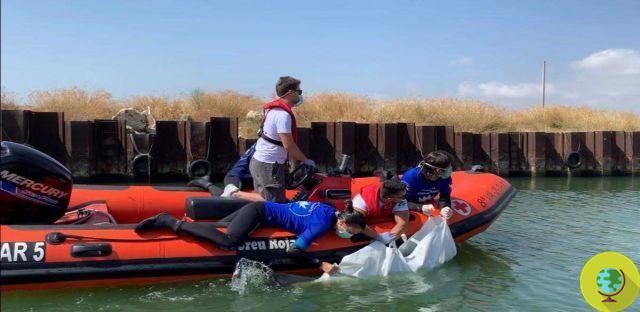A new viral strain more deadly for cetaceans circulates throughout the Mediterranean: it is always morbillivirus, which kills dolphins.
A new viral strain more deadly for cetaceans circulates throughout the Mediterranean: it is always morbillivirus, whose different strains in the last 25 years have already caused numerous deaths. As early as 1990, a thousand dolphins died in the Mediterranean and today still the most lethal and dangerous virus for the dolphins and all the cetaceans it is circulating again in our seas.
According to scientists from the Fundación Oceanogràfic and the Sicilian Zooprophylactic Institute, the same pathogen detected in the Valencian Community killed seven dolphins in Sicily. A real massacre, but researchers need more research to determine how this morbillivirus moves and what its potential impact on the cetacean populations inhabiting the Mare Nostrum may be.
But what is morbillivirus? How does it affect dolphins?
“Morbillivirus is now the most lethal pathogen for cetaceans - explains Consuelo Rubio-Guerri, research coordinator of the Oceanogràfic Foundation. In wild animals it is very difficult to control the action of such a pathogen, so for the moment we do not plan to develop a specific vaccine or treatment, but it is important to know as much as possible about the disease and its evolution ”.
In the last quarter of the century, several variants of this pathogen caused masses epidemic with high mortality worldwide, of which the most serious, in 1988, killed about half of the bottlenose dolphins in the American Atlantic.
The cetacean morbillivirus was first described in 1990. It was later confirmed that the large mass mortality of bottlenose dolphins observed on the American Atlantic coast in the late 80s was due to this pathogen and not, as initially thought, to a toxic agent. Affected animals showed symptoms of a strange combined condition pneumonia, encephalitis e damage to the immune system.
In the last 25 years different strains of morbillivirus have caused numerous and massive outbreaks. In 1990, a thousand dolphins were found dead in the Mediterranean and shortly thereafter about a hundred dolphins in the Gulf of Mexico. Other episodes, then, in the Mediterranean, occurred between 2007 and 2011.
Last year, Rubio-Guerri's analyzes of five dolphins collected on the Valencian coast helped explain the change in disease: these animals, killed as isolated cases rather than in true great epidemic, had been infected with a strain of the new virus in the Mediterranean, most likely introduced by Atlantic animals.
Now the new dead dolphins confirm this hypothesis. As the researchers explain in Scientific Reports, the strain that killed these dolphins shows "substantial differences" with that found in epidemics in the Mediterranean in 1990, 2007 and 2011, while it has similarities with variants found in the Atlantic in 2007, 2011 and 2013. .

Scientists do not yet know why the new strain does not cause outbreaks, although it is more aggressive in affected individuals. One possibility is that most, but not all, dolphins already have immunity against this variety.
Meanwhile, the veterinary Chelo Rubio clarifies that the morbillivirus comes from the measles family in humans or from the distemper in dogs, that is, it belongs to the Paramixoviridae family. Until 1988, only four of these types of viruses were believed to exist: measles, canine distemper, rinderpest, and ruminant parasites. It was then that the dolphins began to die from a strange disease that mainly affects the respiratory and nervous systems, which causes an immune deficiency and which causes the death of dolphins (and other cetaceans) due to secondary infections and not from the virus. same.
In short, this new strain would also belong to this family and is known as cetacean morbillivirus or, also, dolphin morbillivirus. However, they are not the only ones affected because it would also be "split into three distinct groups: the porpoise morbillivirus, dolphin morbillivirus and pilot whale morbillivirus," as pointed out by Manuela Echeverri-Zuluaga and her team in the Dolphin Morbillivirus study. .
In short, the "struggle" is long and hard. What is certain is that the cetacean morbillivirus is a species-specific virus and is not a disease that can be transmitted to humans.
Read also:
- This pregnant whale died trapped in an abandoned ghost fishing net in the ocean
- The Pesaro baby turtles saved from the storm and Luciana's children were born: 32 of them are already at sea
Germana Carillo
Gallery


























